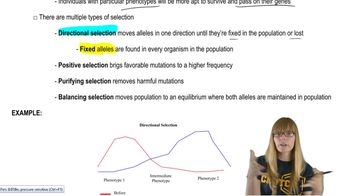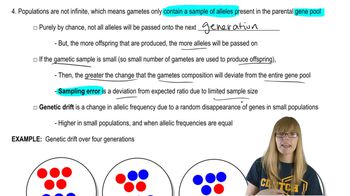Table of contents
- 1. Introduction to Genetics51m
- 2. Mendel's Laws of Inheritance3h 37m
- 3. Extensions to Mendelian Inheritance2h 41m
- 4. Genetic Mapping and Linkage2h 28m
- 5. Genetics of Bacteria and Viruses1h 21m
- 6. Chromosomal Variation1h 48m
- 7. DNA and Chromosome Structure56m
- 8. DNA Replication1h 10m
- 9. Mitosis and Meiosis1h 34m
- 10. Transcription1h 0m
- 11. Translation58m
- 12. Gene Regulation in Prokaryotes1h 19m
- 13. Gene Regulation in Eukaryotes44m
- 14. Genetic Control of Development44m
- 15. Genomes and Genomics1h 50m
- 16. Transposable Elements47m
- 17. Mutation, Repair, and Recombination1h 6m
- 18. Molecular Genetic Tools19m
- 19. Cancer Genetics29m
- 20. Quantitative Genetics1h 26m
- 21. Population Genetics50m
- 22. Evolutionary Genetics29m
21. Population Genetics
Allelic Frequency Changes
Problem 40a
Textbook Question
Divide the contents of a large bag of different-colored candies randomly and approximately equally among the members of the group. Do not pick specific candy colors, but simply empty the contents of the bag onto a table and quickly divide the pile. If you are doing this exercise by yourself, divide the contents of the bag into five piles. Identify what phenomenon explains the observed differences. What evolutionary mechanism do the observations emulate?
 Verified step by step guidance
Verified step by step guidance1
Identify the phenomenon: The observed differences in the distribution of candy colors among the piles can be explained by the concept of genetic drift.
Understand genetic drift: Genetic drift is a mechanism of evolution that refers to random changes in the frequency of alleles (variants of a gene) in a population. It is most significant in small populations.
Relate to the candy example: In the candy example, each pile represents a small population, and the random distribution of candy colors emulates how allele frequencies can change randomly in small populations due to genetic drift.
Consider the effects: Just as some piles may have more of one color than another purely by chance, genetic drift can lead to certain alleles becoming more or less common in a population over time, independent of natural selection.
Conclude the analogy: This exercise demonstrates how genetic drift can lead to variation in genetic makeup within populations, similar to how the candy colors vary among the piles.
Recommended similar problem, with video answer:
 Verified Solution
Verified SolutionThis video solution was recommended by our tutors as helpful for the problem above
Video duration:
2mPlay a video:
Was this helpful?
Key Concepts
Here are the essential concepts you must grasp in order to answer the question correctly.
Genetic Variation
Genetic variation refers to the differences in DNA sequences among individuals within a population. This variation is crucial for evolution as it provides the raw material for natural selection to act upon. In the context of the candy exercise, the different colors represent genetic traits, and their random distribution mimics how genetic traits are passed on and mixed in a population.
Recommended video:
Guided course

Genomic Variation
Natural Selection
Natural selection is the process by which certain traits become more or less common in a population based on their advantages or disadvantages in a given environment. In the candy division, some colors may be more desirable or advantageous, similar to how certain genetic traits may enhance survival or reproduction, leading to changes in the population over time.
Recommended video:
Guided course

Natural Selection
Random Sampling
Random sampling is a method used to select a subset of individuals from a larger population in a way that each individual has an equal chance of being chosen. This concept is essential in genetics as it reflects how alleles are randomly assorted during reproduction. The random division of candies emulates this process, illustrating how genetic traits can be distributed unpredictably among offspring.
Recommended video:
Guided course

Non-Random Mating

 5:58m
5:58mWatch next
Master Natural Selection with a bite sized video explanation from Kylia Goodner
Start learning


